Tim Mathis's Blog, page 2
April 2, 2024
The Best Travel Guidebooks of the Last 50 Years (and Why they Still Matter)
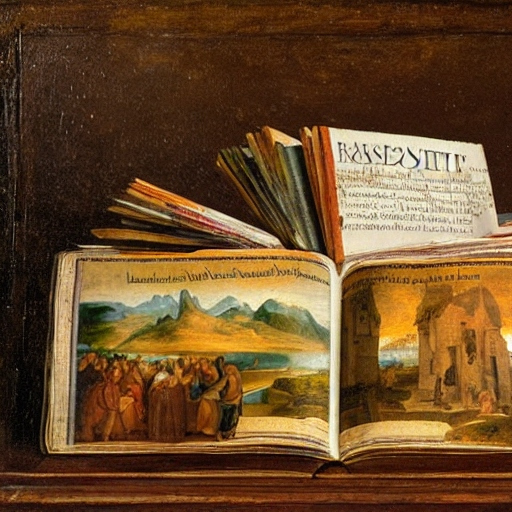 The travel guidebook is dead. Long live the travel guidebook.
The travel guidebook is dead. Long live the travel guidebook.
In the internet age, and particularly since the rise of the smartphone, prophets of doom have predicted the imminent demise of the travel guidebook. While the robots may indeed be coming for us all, I do think that there’s a hopeful future for this seemingly old-fashioned tool. I believe that in part because I spent a few years immersed in the genre while I was working on my own book about the Camino de Santiago, The Camino for the Rest of Us.
While travel guidebooks aren’t usually thought of as literary works, across the last fifty years, several have been undeniably important. A few guidebooks have shaped travel culture itself, and have helped turn travel into a central aspect of modern life. They have helped make travel seem possible, but just as importantly they’ve made it seem broadly appealing. They’ve helped people to understand why they should travel, not just how, and they’ve helped average Joe Bloggs like myself make it to places like New South Wales, New Caledonia, and New Zealand.
That sort of travel guide, I think, is not going away anytime soon. Here are the books that I’d place in that category:
Across Asia on the Cheap. 1973. Maureen and Tony Wheeler.
The original Lonely Planet guide was self-published by a couple of Australian hippies, in order to give other hippies advice about where to find the best pot and hostels in Asia. That book, and its Lonely Planet descendants, helped transform backpacking from a niche countercultural interest to a central rite of passage in much of the Western world. The original proto-Lonely Planet wasn’t much more than a long pamphlet, written in a thoroughly informal style. However, it immediately struck a chord with the type of (mostly European) seekers who’d started drifting overland between Europe and Southeast Asia in fried-out Kombi’s (heads full of zombie…). The authors, Maureen and Tony Wheeler, were entrepreneurial and built on the success of that guide to develop a global brand that contributed massively to the growth of international budget travel for decades. Across the years they kept some of their early budget ethos, but by the 2000s Lonely Planet guides didn’t resemble Across Asia on the Cheap in any significant way. They hired armies of young, poor travel writers to give updates on local hostels and destinations, which is cool, but their books developed into thousand-page encyclopedic tomes covering most everywhere you could dream of visiting. (The Wheelers sold the brand off piecemeal to the BBC in 2007 - 2011, making something like $100 million on the deal. Since then the brand’s lost quite a bit of money, luster and influence.) You can get their OG ‘best travel guidebook ever’ for free online now, which seems appropriate.
Rick Steves’ Europe Through the Back Door . 1980. Rick Steves.
Nowadays Rick Steves’ guides are much nerdier than Lonely Planet guides, and are marketed to an older, more American audience. Still, their genesis was remarkably similar to the Lonely Planet story. Rick went to Europe as a young adult, fell in love with it, and wrote a free travel guide to help promote his tour guiding hustle. People on his trips stole the guide, so he decided to give the people what they want, and self-published the first edition of Europe Through the Back Door. As with Lonely Planet, he expanded on this book’s success to write dozens of other guides, primarily focused on European travel. Europe Through the Back Door was informal, niche, funny, and budget minded. Because he’s stayed integrally involved with the brand, the voice of these books haven’t changed much over the years. Rick Steves came off as goofy, smart, and likable in his first book, and that personality has carried through across the years. Steves has been less influential than Lonely Planet with the international backpacking crowd, but he’s arguably the most important authority for typical American travelers. Along with the books, he’s created an entire brand through television shows, a radio program, and online resources that keep a personal feel. Angel and I always use his free audio walking tours when we go to Europe.
Let’s Go! Europe . 1961. Oliver Koppell.
Let’s Go! didn’t survive the onslaught of the internet and the pandemic, but for a time it was the world’s bestselling budget travel guidebook brand (at least according to their marketing department). While it’s a quintessentially (privileged) American version of the story, the genesis was once again very similar to the Rick Steves and Lonely Planet guides. In fact, it deserves credit because it pre-dated both of them. In 1960, a Harvard Freshman named Oliver Koppell went to Europe, loved it, and wrote a 25 page pamphlet to hand around to other students on their way to the continent. It was Harvard, so initially these were distributed on private flights that the university chartered for their Student Association. It started first as a free product for his peers, but Koppell and Co. were savvy, and his dad (of course) had connections. The idea gradually developed from pamphlets into full books, and then into a global guidebook brand focused on budget and student travel. It was offbeat, opinionated, and fun to read. Lonely Planet gets most of the credit for the development of modern backpacking culture, but Let’s Go! came first, and deserves props for enabling decades of (maybe a bit entitled) American college kids to spend their summers wandering in Europe. (Full disclosure: I haven’t read the original, but their USA book was the first travel guide that I ever bought. I loved it, in case you’re wondering.)
The People’s Guide to Mexico by Carl Franz and Lorena Havens. 1972.
According to the authors, The People's Guide to Mexico started as a series of letters to their friends in Alaska who were thinking of joining them on a van tour of Mexico. It developed into the only travel guide that I’ve personally read just for fun. (You can probably even hear the influence in the title of my book, The Camino for the Rest of Us. I’m a hack, I admit it.) It’s gone through more than a dozen versions across the years, but is one of the few guidebooks that consistently retained it’s original character - a chaotic, madcap collection of travel advice, personal stories, historical background, and cultural experiences. Unlike the others, it didn’t develop into a series, but across the years it did expand, and the most recent edition is over 600 pages. While Lonely Planet guides became encyclopedic and somewhat sterile (if also useful in their way), The People’s Guide kept its early DIY feel and. Its length grew by shoving in more stories, chaos, and fun. Like the other guides, it was clearly written originally by enthusiasts, and it’s still a book about how to travel in Mexico (slowly and flexibly), as much as where to travel. Using it, you never lose sight of the fact that you’re learning from a couple of old gringos who just really love the place. It’s an extremely likable piece of work if you’re a certain kind of traveler.
 What makes the best guidebooks endure? Personality, curation, innovation, and accessibility.
What makes the best guidebooks endure? Personality, curation, innovation, and accessibility.
Basic, useful travel information was a key backbone of all of these books and their associated brands, but a shared set of features distinguished them from other guides. These features, I think, are what set them up to endure.
In their early forms, all of these guidebooks were written from a personal perspective and produced with a DIY ethos. That approach guaranteed that readers knew they were getting advice from someone who’d been there and had the experiences themselves. It felt like insider information rather than test-marketed pablum. It also meant that they were fun to read. They read like conversations with a friend who’s just gotten back from a trip that changed their life, who wants to help you do the same.
None of these guides were comprehensive in their early forms, but felt like curated advice about how to have a particular type of travel experience. They didn’t review every restaurant, museum, or hotel, but they did provide the knowledge readers needed to enjoy a summer touring European capitals by train, or following the Hippie Trail through Thailand, or drifting in a van around Mexico. All of the guides burst with enthusiasm for their approach, and spread a gospel of true belief in a specific sort of life experience.
In that vein, all of these books were saying something important about travel that wasn’t being said elsewhere at the time. In Across Asia on the Cheap, that was “Hey guys, in Asia you can totally drop out of the rat race and experience the world for months (or even years) if you save up a few hundred bucks.” In The People’s Guide to Mexico it was “Hey gringos, there’s this colorful, relaxed, endearing world that’s different from anything you’ve experienced, and it’s right across the border.” For Let’s Go and Rick Steves it was something like, “Hey Americans, Europe is close, approachable, and endlessly fascinating.”
All of these books were populist in the good sense, and focus on making extraordinary experiences accessible to regular people. (That’s even true of Let’s Go, produced by rich kids at Harvard.) While travel can often seem like a rarified practice reserved for the wealthy, in tone, all of these guides communicated that anyone can do this stuff. They reassured European kids that they could figure out the chaos of Pakistani border crossings, and American vacationers that Parisians won’t actually harass them if they can’t speak French.
Even if the internet has killed encyclopedic hostel guides, people still need the things that these early travel guidebooks provided. They need insider advice from people who “get it.” They need to know what travel experiences they might be missing. They need to feel like their trip fits in with something bigger. They need to know how to travel where they’re going, and why. And, I’d say, they need to connect with writers who are as excited about the trip they’re planning as they are.
It’s not surprising then that some of the most popular recent travel books tap into the elements that have helped those classic travel guides endure. These aren’t location guides, per se, but…
Vagabonding by Rolf Potts is a modern classic, and a personal, narrative manifesto about how to be a backpacker (philosophically), based on years of personal experience. While it’s not location specific, it is about a classic type of experience: long-term, undirected world travel. And while it wasn’t independently published, Potts did cut his writing teeth in the wild west of early freelance travel blogging.
How to Travel the World on $50 a Day by Matt Kepnes is kind of the Rick Steves to Vagabonding’s Lonely Planet, if that makes sense. It’s a nerdier guide to long-term backpacking that’s much more targeted to practicalities, but is written to enable people to do the sort of thing that Potts was talking about. Kepnes got his start building a DIY blog, and has developed his brand into one of the most influential forces in modern budget travel.
In a slightly different vein, perhaps the most novel modern incarnation of vagabond culture, “vanlife,” has been informed in large part by DIY communicators. Bloggers and YouTubers have been key influencers, while the bibles have been written by independent and self-published authors with a strong sense that they’re writing about a movement, How to Live in a Van, Car, or RV - And Get Out of Debt, Travel and Find True Freedom by Bob Wells is the most venerable, and is a charmingly DIY product. (Wells’ was enshrined culturally when he featured as a sort of vanlife guru in the book and film Nomadland.)
None of those books are about particular places, but they do tap into the same human needs that made those earlier guidebooks popular: identity, adventure, practical advice, and aspirational visions about what’s possible. In fact, you could say that these are modern books about how to participate fully in the culture that the classic guidebooks like Lonely Planet and Rick Steves helped create. (Side note/shameless plug - I wrote my own previous book, The Dirtbag’s Guide to Life, in a similar spirit.)
In recent years, the closest location-specific analogues I’ve found to the classic guides are the Wildsam Field Guides, which are focused on travel to curated destinations in the US. The founder, Taylor Bruce, originally envisioned these guides as a thorough re-imagining of the travel guide focused on capturing the spirit and culture of places vs. just providing a list of places to visit. Like the older guides, the first version (a book about Nashville) was self-published, and sold thousands of copies in its first months of existence before he decided to expand the project into a wider series.
Reports of the guidebook’s demise have been greatly exaggerated. Sales have stabilized in recent years, and people are clearly still finding value in travel guides - at least of a certain type. Still, the travel writing world is going through an existential crisis, and has been for more than a decade.
The good news is that an existential crisis is probably useful every once in a while. In life, a sense of impending doom triggers you to refocus on your priorities. In travel writing it’s the same. What type of guidebook even matters? What’s a guidebook for these days? Beyond what’s marketable, what’s a travel guidebook contribute to the world? Those are the sorts of questions you have to ask if you’re trying to write a book these days.
Looking back at these classic guides, it’s possible to pull out some common traits that make guidebooks essential. Personally, I hope that this is the direction that travel guides will be moving - back towards personal, curated, innovative books written to open up extraordinary travel experiences for average people. I think there are some good signs. Even if the internet does seem like its trying to kill everything good these days, I don’t think the robots are destined to win.
----
When I started writing my upcoming book The Camino for the Rest of Us , I wanted to create a guidebook in the classic vein.
Hundreds of thousands of people walk the Camino de Santiago every year, but it’s a strange and widely misunderstood travel experience. Logistical information is easily available online and in other guidebooks, but it’s also a trip that screams for a personal tour guide.
So, I wrote a book that’s thoroughly personal and niche. My voice and stories are a big part of it. I’m an unapologetic stan for the Camino when it’s approached in a certain way, so I teach the Camino strategy that I think works best. My revolutionary message is that pilgrimage is for everyone, so the book comes from a particular and unusual angle: teaching pilgrimage to pilgrimage skeptics. Rather than trying to cover all of the hostels and restaurants and attractions along the way, I focus on covering everything you need to know in order to have a transformative experience.
Why? Because I love the Camino, and I want to help people have a particular kind of travel experience. And, yeah, I want to participate in the starry-eyed, DIY, idealistic tradition I've been describing here. Like independent authors before me, I believe that the right type of travel guide can be magic, and can help open up possibilities that wouldn’t exist otherwise.
The Camino for the Rest of Us will be released on May 6, 2024. Sign up for the email list on the homepage for previews, background and updates. (I'm not spammy, I promise. The list is mainly friends and family and a few people who've connected because they like my books.)
March 5, 2024
Review of Trash: A Poor White Journey by Cedar Monroe
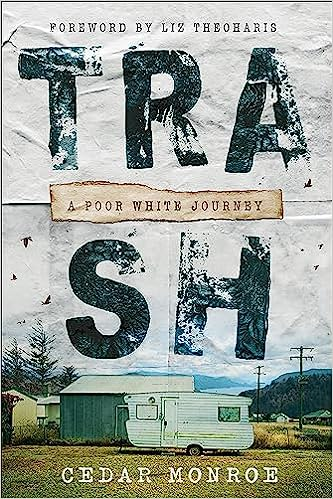 Trash by Cedar Monroe: A beautiful, hard book
Trash by Cedar Monroe: A beautiful, hard bookI used to be a minister and a Christian. When I was a part of that world, here’s my assessment of what people were like:
Most were normal folks who happened to have been raised in a religious community and saw church as an avenue toward a good life. A few people were genuinely terrible - real predators who were there because church culture makes power easily accessible and people particularly vulnerable. Gross. And a few were as close to saints as humans can get - people who were genuinely principled and committed to putting others’ needs ahead of their own. They were the model few who helped you hold out faith that all of the religious stuff wasn’t just a scam.
One of those near saints was Cedar Monroe, a person I met when we were both young, in our 20s. We were both in the process of discernment for ordination in the Episcopal Church. I flamed out (,,and wrote a book about it), but they carried on, went to seminary, and started a ministry among the unhoused population in Grays Harbor, Washington. It’s been more than a decade since I’ve seen them, but I heard that they were publishing a book about their experiences, so I asked if I could be an advance reader. The book is called ,,Trash: A Poor White Journey.
Cedar’s life has been a lot different from mine, and probably a lot different from yours. In fact, their experience is probably a lot different from anyone you know. That must make for a lot of stress, but also good memoir. At heart, that’s what Trash is.
Cedar tells their story of growing up poor and fundamentalist, mainly in Grays Harbor. Their parents were struggling, frustrated, and poor. They were also a part of the Quiverful movement, where the brand identity is a rigid commitment to family expansion and procreation. Cedar read a lot, worked through questions around gender and sexuality, and left the culture they were raised in.
At the beginning of the book, Cedar draws a comparison to J.D. Vance’s story in Hillbilly Elegy, and the parallel is obvious to some degree. To make his escape from poverty, Vance started in the military and then went to Yale. Monroe went a church route. After becoming an Episcopalian during the period when we knew each other, Cedar was approved to pursue ordination and went off to seminary in Cambridge, Massachusetts, and took some courses at Harvard. Like Vance, they were a fish out of water in upper crust New England, struggling to fit in alongside the privilege and moneyed culture that’s pervasive among Episcopalians, and particularly seminarians.
After his Ivy League experience, J.D. Vance went to work for a hedge fund and became a mascot for the uber-wealthy. Monroe, on the other hand, went back home to Grays Harbor to try to make a meaningful difference. They started a ministry working primarily with folks living in a modern shanty town, squatting at “The River” - a stretch of disused land along the Chehalis in Aberdeen. This is where the real meat of the book develops, and it’s what the book is really about.
If you’ve been there, your impression is probably that Grays Harbor is rainy, beautiful, and poor. Aberdeen is an old logging town and a community where most of the jobs have moved away. In ways, it’s not so different from J.D. Vance’s Rust Belt hometown in Middletown, Ohio (which is actually my hometown as well), but it’s a particular brand of depressing. The proximity to wealth highlights the poverty. Washington is the third richest state in the country with a GDP per capita of $90,000 - which would place it above every country in the world outside of a few oil states and small tax havens. In Grays Harbor, the average income is well less than half that. The grey and rain add an element of seasonal depression. The boom and bust nature of logging and fishery work creates a cycle of raised (and then dashed) hopes. Kurt Cobain is from there originally. It’s a hard place.
Cedar’s work in Grays Harbor took on a Catholic Worker-style incarnationalism - living among the poor, and doing the fundamental stuff of on-the-ground activism. Helping people with food and shelter. Praying for people who rarely experience care from people with power. Leading funerals for those who die on the streets and don’t have contactable family. Visiting people as they cycle in and out of prison. Standing between cops and homeless people during ruthless camp sweeps.
It’s heavy stuff, obviously, but the real strength of the book is the picture it gives of a community. This isn’t exactly a story about homelessness as a social problem, although Monroe does include a lot of interesting history and sociology to help explain how we got to where we are. It’s a survey of stories about what human beings do when they’re shoved into an untenable situation without resources to escape it. There’s hope and humor, but there’s nothing rose-colored here. The book is full of likable people making bad decisions, and seriously mentally ill people living in squalor trying to survive. Or addicts in a cycle. Or abused people abusing others. Some, against the odds, climb out. More often, they die young or continue to drift along through trauma after trauma.
The book revolves around the theme of “white trash,” and it’s a picture of a mostly white community, for sure. However, Monroe ties white poverty to bigger themes. They talk about creating literal connections between the community along the River and the national ,,Poor People’s Campaign, and tell stories about the connections that develop between the poor white people in Grays Harbor and the poor indigenous people who’ve lived in the area for time immemorial. They talk about philosophical similarities with movements in poor African-American communities and the challenges of uniting these poor communities into a shared movement to create political change.
As a discussion of poverty in America, there’s nothing particularly pat or blindly hopeful here, but there’s a lot that feels very real. To me that’s more useful: Here’s the problem. Here are some solutions (which all seem like long shots). In the meantime this is what people are going through: their homes are bulldozed, their towns hate them, and they can’t get out even if they want to. The cycle is getting worse. Locals threaten and harass them. Police shuffle them off, but to where?
What it feels like, as opposed to Hillbilly Elegy, is an honest picture of reality in the United States, and a realistic assessment of how much work it will take to change it. It’s a description of the real community that forms in the midst of dire poverty despite the challenges - the positive character of the people living in places like The River, and the barriers (personal and structural) to escaping the muck that sucks people down time and again. It’s a stark picture of the complex set of problems creating a uniquely American issue - massive amounts of extreme poverty alongside the world’s highest concentration of wealth.
It’s one of those books that you finish and need to sit with your feelings for a bit. There’s a vague sense of hope, but it feels like the sort of hope you hold out because what else can you do? And it’s not a hero narrative for Monroe as someone who’s trying to make a difference. It’s a story about how hard all of this is to deal with.
Trash is a beautifully written story that hits on big, relevant themes. I’m excited to see how this book does. It’s well worth a read, particularly for people interested in the intersectional struggle against poverty in the USA, or those wondering why so many homeless people are around, and what it’s like to be one of them.
And for a bit of shameless self-promotion, if you like Trash, you'll probably also like I Hope I Was Wrong About Eternal Damnation .
November 26, 2023
Adventures with Emilie: A Te Araroa Trail Book Review
I rarely write reviews here. When I do, it's because I've found a great book that I'm worried you might miss.
Adventures with Emilie: Taking on Te Araroa Trail in 138 Life-Changing Days is a great book that I'm worried you might miss.
 First things first, the world needs a great Te Araroa Trail book.
First things first, the world needs a great Te Araroa Trail book. I read a lot of books about long walks, and all of the great trails have inspired real gems. The Camino is a source of at least one proper classic - The Pilgrimage by Paolo Coelho - and the less known, but still great Walking to the End of the World by Beth Jusino. The Pacific Crest Trail produced Wild by Cheryl Strayed, Thirst by Heather Anderson, and Thru Hiking Will Break Your Heart by Carrot Quinn. All three are brilliant. If you want to read about the Appalachian Trail, Bill Bryson tells his story hilariously in A Walk in the Woods, and Grandma Gatewood’s Walk by Ben Montgomery immerses you in the trail’s early history and one of its best stories. Even fake long walks have their recent highlights. The Unlikely Pilgrimage of Harold Fry by Rachel Joyce introduces classic pilgrimage concepts through a heartwarming story about an old man’s impulsive journey across Britain. (Also, honorable mention to Brian Livingston’s charming book about the fictional Great Eastern Trail - The Habits of Squirrels.)
Te Araroa is a relatively newly established route, running the length of New Zealand from North to South. It's been waiting for a few decades for someone to write a great book about it.
Adventures with Emilie is it.
Capturing Te AraroaThe phrase "Te Araroa Trail" sounds a bit clunky to the English speaking ear, but it is in fact the correct phrasing. "Te" is a Maori term meaning "the," and "Araroa" roughly translates to "long path." Don't call it the Te Araroa, that's redundant.
The origins of the route trace back to the '70s, but it opened publicly as an actual, functional trail that you could complete in 2011. Mainly owing to the explosion in thru hiking culture in the US and Europe, but also due to the allure of New Zealand, it has developed an international reputation much earlier in its life than the North American long trails. It's a unique, appealing experience - a long walk across small islands through big mountains at the end of the earth.
It's also really challenging. We've done about 400 km of the trail ourselves, and it's properly rugged. It's 3000 km long in total, and a lot of the time you move at 1 - 2 km/hour. It's a lot of steep ascents, rough terrain, brutal weather, and difficult river crossings. For comparison with the American long trails, it has more difficult terrain than the PCT, more logistical complexity than the AT, and weather patterns just as difficult to manage as the CDT. It’s a trail with unique challenges, which genuinely isn’t like any other long walk in the world.
It deserves to have its essence captured on paper.
 What is Adventures with Emilie?
What is Adventures with Emilie? The dramatic set up for Adventures with Emilie is that Victoria Bruce is a single mom in her mid 30s, who's burnt out at work and haunted by the ghost of a traumatic childhood. Despite outward success, her life feels suffocating. The only moments of respite she finds are weekends spent with her 7 year old daughter Emilie tramping in the hills around Christchurch. Eventually, when she realizes that she isn't managing at work (and doesn't actually want to), she decides to quit her job, pack her bags and hike Te Araroa with Emilie. The book is the story of their experience together.
The task for any good thru hiking book is to capture both the trail itself and the human drama that accompanies it.
New Zealand is famously beautiful, and it's a real challenge to do it justice. Victoria Bruce’s writing captures the landscape without feeling overdone. She immerses you in the geography, flora and fauna, but doesn’t get hung up on details to the point of distraction. New Zealand’s mountains are both some of the most dramatic in the world and the most treacherous, and she captures both elements. She describes beautiful evenings spent tucked between peaks flocked by native birds, alongside a harrowing series of experiences - including a gut wrenching moment where Emilie nearly tumbles to her death in a river gorge.
Despite these sorts of moments of transcendence and terror, the basic features of a thru hike can read as entirely boring. You just walk, eat and sleep for months, until you get the finish.
And it's true, a lot of the time, a thru hike feels like: “Day 168: I have to walk all f%$ing day again.”
A good writer though captures the internal process. When you walk all f%(^ing day for 168 days straight, it becomes a theater for some of life’s most complex internal dramas to play out. A long walk becomes a pilgrimage, whether you like it or not.
Bruce captures that very well.
Without spoiling too much, the author is the product of a severely traumatic childhood, and the natural world was one place where she experienced a sense of joy and home during her complicated upbringing. She’s clear that this hike is a significant bit of therapy for herself during a similarly complicated period of adult life. She brings the reader along on that journey through a series of flashbacks. It's heavy at times, but beautifully written and genuinely informative - an introduction to the embodied experience of post traumatic stress.
At the same time, it's not a solo trip, and she’s walking with her 7 year old daughter. This is clearly part of Bruce's attempt to provide Emilie with an upbringing that's healthier and more connected than her own. Her ongoing struggle is managing the emotional impacts of PTSD and abuse herself while trying to provide her daughter with support and a genuinely extreme adventure. It's clearly a struggle that transcends the hike itself. There’s a lot of raw emotion, and a lot of tension between what she’s feeling and what she allows her daughter to see.
For her part, Emilie comes off as a social, bubbly kid who mostly enjoys the process of six months of rugged thru hiking. You get the impression that she’s a child who’ll grow up with a sense of possibility much bigger than most. There’s a powerful picture of a parent doing the best they can here. Bruce uses the term several times to describe Emilie, Wahine Toa - warrior woman. She clearly gets that from her mom.
When you put all of its elements together, you get a consistently interesting book. Bruce captures the external and internal journey of this particular thru hike very well, and tells a remarkable story in a straightforward way. It's a book about a trip with a kid that clearly isn’t a book for kids. It's beautiful nature writing alongside nuanced self-psychoanalysis. It’s a consistently good read.
Where does Adventures with Emilie sit in the thru hiking canon?To this point, in my opinion, Adventures with Emilie is the best book on Te Araroa, and it's worthy of a spot in the thru hiking canon. It'll have more appeal within the thru hiking community than Wild or A Walk in the Woods, but it describes the internal journey more effectively than Thru Hiking Will Break Your Heart. It combines many of the best elements of thru hiking literature and at times feels similar to Thirst. The book it most reminded me of, actually, is Carrot Quinn's The Sunset Route. That isn't a thru hiking book at all but is a story about processing life with a schizophrenic mother on a series of rail hopping journeys in the western US.
In any case, Adventures with Emilie was published by Penguin New Zealand. My hope is that they’ll give it some focused promotion in the States. For the time being though, you can buy it anywhere through Amazon.
It’s a great book. I think you’ll like it. I didn't want you to miss it.
October 21, 2023
After the Camino: What to do in Santiago de Compostela
<< Back to Iria Flavia to Santiago to Compostela: The Final Day of the Portuguese Coastal Camino
Santiago de Compostela is a fantastic destination for any tourist, but on the days after finishing a Camino, it's a perfect place to absorb the rich stew of the Way's history and current reality. The city is full of places to explore, but here are some of the highlights, and the things you don't want to miss while you're resting your feet and celebrating your achievement.
 What to do in Santiago after finishing your Camino
What to do in Santiago after finishing your CaminoRegardless of why you’ve walked the Camino, Santiago de Compostela is a lovely place to finish. It’s full of history and myth and spirituality - centered on the Cathedral experience, and splaying out into various other churches and chapels throughout the city. There is more than enough culture, food and fun if you just want to celebrate and wind down. Santiago is a stunning city and a great place to wander - as if you haven’t had enough walking. It’s no simple finish line but a whole culture built up across the centuries by the Camino.
Here are some of the best things to do while you’re in town. Pick your priorities, but if you're intrepid you could do everything on this list in 2 - 3 days.
First things first, make sure you pick up your compostela confirming that you’ve finished the Camino. The Pilgrim’s Reception Office is just around the corner from the Cathedral, on Rúa das Carretas. Stop in as early in the day as you can - they implemented a sophisticated ticketing system a few years back to deal with long wait times (the future is now on the Camino) but the advice is still to get in early to make sure you get your certificate before the office closes. Normal hours are 9 AM - 7 PM.

The Cathedral was constructed across the 12th and 13th centuries and is one of the most important in the world by any measure. Pass through the complex, stunning Pórtico de la Gloria to formally complete your pilgrimage. Take the guided rooftop tour for a spectacular view of the city. Wait in line to visit the crypt, commune with the dead saint’s bones, and hug the statue. Attend one of the daily pilgrim’s masses. Visit the attached museum to see preserved bits of Cathedral history from centuries past. You’ve come this far. Don’t miss out!
Wander the Cathedral square - the Plaza del Obradoiro - and the Old Town (Casco Antiguo) for atmosphere and celebration. It’s a Unesco World Heritage Site and a center of the process of winding down after the pilgrimage. This is where you’ll find endless options for food and drinks catering to locals and travelers, and where you’re bound to run in to people you met along the way.
Visit the Museum of Pilgrimages and Santiago in the square facing the Cathedral, the Plaza de Platerías. Santiago is full of of museums and historic buildings, but this is a great one to finish out a pilgrimage. It’s full of interesting history and insight into what you’ve just done, displays are in English and Spanish, and entry is cheap!

Late at night, across the Praza do Obradoiro from the Cathedral, a charming Camino tradition takes place. Musicians gather under the cover of the Neoclassical Pazo de Raxoi to play traditional Spanish music for donations most nights. It’s an informal celebration with pilgrims completing their journey, and it’s a perfect way to close out a long walk. Santiago is a city full of music, so even if you don’t find the musicians here, it’s likely that you’ll find someone playing in a park or a bar if you spend a bit of time looking.
There are plenty of accommodation options of all types, but a few are notable. If you want a serious splurge, stay at the Santiago Parador: The Hostal de los Reyes Católicos. It used to be a pilgrim hostel. Now it’s a pricey five star hotel. It’s the place where Spanish royalty stay when they visit, so you can set your expectations high. For a different vibe stay in one of the many albergues. The Albergue Seminario Menor close to the old town is huge but beautiful - one of the nicest albergues on the Camino, situated on the well-manicured grounds of a renovated seminary. If you prefer a private room after all of those nights in bunks, they have them available. You’ll likely need to book well ahead, but the Hospederia San Martin Pinario is a fantastic middle ground option that’s well worth planning for - affordable and pilgrim focused private accommodation in an old monastery in the Cathedral square with private rooms and options for fancy if you want it.
Even if you didn’t book in early enough to stay there, vIsit the Monastery of San Martin Pinario. The current impressive Baroque structure is from the 15th century, but the monks established here in the 9th century, shortly after James’ bones were discovered. You won’t find a closer connection to Camino history outside of the Cathedral itself.

Stop in a cafe to eat some Tarta de Santiago. Almond cake with lemon and brandy, decorated with the Cross of St. James. Maybe you’ve had it already by this point but why not commune with the Saint a bit more in his hometown?
Wander to the Mercado de Abastos - one of the more beautiful markets in Europe. It’s a nice spot to gorge on local delicacies, especially if you’re on a budget.
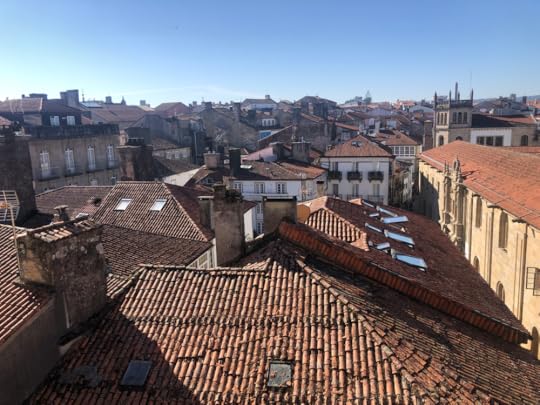
Wander through the Parque de la Alameda - a grand 16th century park near the Old Town with fantastic Cathedral views.
If you haven’t had enough of old churches, you’ll find endless options, but the Colegiata de Santa María del Sar is one of the oldest and most picturesque. It’s a 12 century structure a bit out of the center on the Sar River. It’s worth the walk out if you have the time. Similarly, the Convento de San Francisco is worth a viewing. It’s said to have been founded by St. Francis himself on his pilgrimage to Santiago in the 13th century. The current church is primarily 17th and 18th century but remains of the original structure are present on site.
Santiago is a big, modern city with much more on offer than this. You’ll find great food variety, craft beer, good wine, museums and endless shops. If you can, plan to spend at least a few days. It’s a great place to finish a pilgrimage, ancient and modern.
<< Back to Iria Flavia to Santiago to Compostela: The Final Day of the Portuguese Coastal Camino
Iria Flavia to Santiago de Compostela: The Final Day of the Portuguese Coastal Camino
<< Back to Vilanova de Arousa to Iria Flavia: Spiritual Variant Day 3
Forward to After the Camino: What to do in Santiago de Compostela >>
In this introduction to the stages of the Portuguese Coastal Camino, I'm focusing on the stuff you actually need to know. You'll sort out accommodation and restaurants and so forth on your own as you travel. I'll cover the things that you don't want to miss along the way. For everything else, check out this article: What do you REALLY need to know about the Portuguese Coastal Camino?
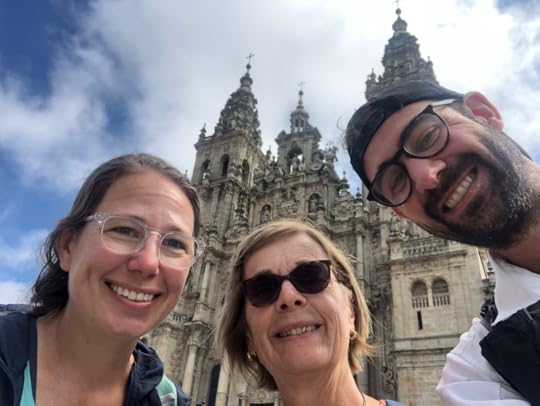 Distance
Distance23 km/14.3 miles
TerrainThis section has a reputation for having a lot of uphill. It’s 800 feet across about 10 miles, then a bit more up and down. That's really not that much. It definitely isn't anything to worry about if you've made it this far. The path is a mix of pavement and cobblestone with some occasional dirt trail. You'll pass through rural farmland and small settlements between Padrón and Santiago, before an urban walk into the city.
 Experience: Iria Flavia to Santiago de Compostela
Experience: Iria Flavia to Santiago de CompostelaFor most everyone, this stage is defined by the pull of Santiago de Compostela, but there are still some things left to experience along the way.
Wandering past the cemetery and church at ,Santa Maria la Mayor in Iria Flavia is a good way to start this final stage of walking, imagining the thousands years worth of pilgrims who've passed this spot the same way you are.
The first few kilometers of the day follow along roads at times but it's mainly a relaxed walk through agricultural land until you get to Escravitude. Here, you'll have a chance to visit one of the final, impressive old churches that you'll see before you get to Santiago - the Igrexa da Escravitude. There's a fountain here that will allegedly will heal your injuries and illnesses if you drink from it. It's a great place to stop in for a stamp and a reflection as you come to terms with the end of your Camino.
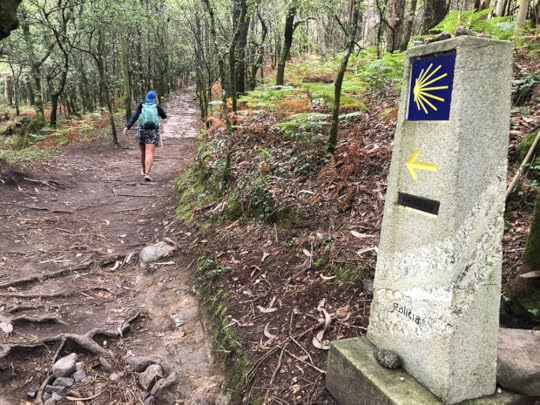
Following a few more miles of walking mostly rural paths and roads, through several small villages you'll get to the more sizeable suburb of Milladoiro, about 7 km from Santiago de Compostela. This is where you'll get your first glimpse of the cathedral. It was traditional for pilgrims to prostrate themselves here, and there is something that hits you about that first sight of your destination. It's like seeing a ghost, or maybe an old friend, after all this planning, preparing and walking. There's a nice little chapel in town that's a popular stopping point for a stamp, and for one last moment of reflection after long walk from Porto.
The normal experience is to walk into Santiago and get a bit confused about where the official Camino actually goes. Follow a map or an app but it doesn't matter much, really. You're walking towards the spires and into thickening crowds of pilgrims, so get there however you want.

Arriving into Santiago from the Coastal Camino, the sheer number of pilgrims might be surprising. They have been converging from all directions - especially the Camino Frances - to meet you here. Pilgrims often hang around Santiago for days after finishing, so the city can have a bit of a festival atmosphere. It’s a town packed with tourists and pilgrims but what else would you expect? Hundreds of thousands making the walk to Santiago ever year.
You'll pass the Parque Alameda less than a kilometer from the Cathedral, and head into your final steps of the Camino.
The quintessential experience is to arrive at the Praza Do Obradoiro in front of the Cathedral for photos and celebration, before settling in to your time in Santiago.
In any case, you've finished the route. Congrats, and buen Camino!
There's a lot to do and see in Santiago, so to conclude this guide to the Coastal Camino, I've written a separate post about the key things you may want to do when you arrive. It's not a walking stage, but Santiago is worth at least a full day on its own, and preferably two.
What to do in Santiago after you've finished.
<< Back to Vilanova de Arousa to Iria Flavia: Spiritual Variant Day 3
Forward to After the Camino: What to do in Santiago de Compostela >>
October 19, 2023
Vilanova de Arousa to Iria Flavia: Spiritual Variant Day 3
<< Back to Armenteira to Vilanova de Arousa: Spiritual Variant Day 2
This post is part of a series of guides about the Portuguese Coastal Camino. If you're looking for the full rundown on that route, have a look here: What do you REALLY need to know about the Portuguese Coastal Camino?
We’re veering from the main route onto the Spiritual Variant. If you want a guide to the alternative sections along the main route, I like ,Pilgrimage Traveler , if you’re looking for a comprehensive turn by turn, or ,Stingy Nomads if you’re looking for more barebones logistics.
Rejoin me at Padrón if you decide against the Spiritual Variant.
 Distance: Vilanova de Arousa to Iria Flavia
Distance: Vilanova de Arousa to Iria FlaviaBoat - Vilanova to Pontecesures: 27.4 km/17 miles
Walking - Pontecesures to Iria Flavia: 4.2 km/2.6 miles
TerrainFor most of today's trip, you'll be on the water. Put on your jacket and enjoy the trip. (Full details for booking your boat are in this prior post but the main thing to know is that most people use the large tour operator, La Barca del Peregrino. Their office is obvious as you walk into Vilanova de Arousa. Book at least a day before, and find out the departure time from the operator, because it fluctuates with the tides.)
Then, it's a few flat kilometers to Padrón, an extremely important spot in early Camino history, and on to Iria Flavia if you like. It's pavement the whole way, if I remember correctly.
 Experience
ExperienceThe water route between Vilanova de Arousa is also known as The Translatio, and it follows the same route that St. James' bones were meant to have followed when they arrived in Galicia from the Holy Land. Along the way you'll pass through what is reportedly the world's only maritime stations of the cross. If you take La Barca del Peregrino, they'll explain, and point out the 12 cruceiros along the way.
It's a beautiful ride along the river, and from start to finish it only takes about an hour and 45 minutes.
The ride itself is really pleasant. It’s easy to imagine St. James passing through here himself, even if the stories about him are almost definitely legendary. The stations of the cross lend themselves to reflection. We had a nice morning with fog breaking up in the hills and adding an air of mystery to the whole experience. Not a bad way to cruise into the final day of this pilgrimage experience.
The boat lands just a few kilometers from Padrón, in the smaller town of Pontecesures. Grab a coffee and some breakfast if you'd like, then follow the Way through the outskirts of Padron along the river. It's nothing spectacular initially, but it’s flat and short.
Padrón and Iria Flavia (just a short walk to the north) are the site of a few crucial bits of Camino history. Not only is this where St. James' bones are meant to have landed, but also this is where St. James himself was meant to have landed on his evangelistic mission in Galicia.
Pilgrims have been passing through here since the 9th century, and some of the very first pilgrims to the shrine at Compostella came through here. After a monk named Paio was said to have rediscovered St. James' burial place, the first person he alerted was the bishop based at Iria Flavia, who was instrumental in establishing Santiago as a pilgrimage site.

Modern day Padrón is a lovely place. As you come into town, you’ll walk right through a serene botanic garden with a nice view of the striking ,Convent of San Antonio de Herbón across the river. Franciscans have been doing what monks do here since the 1300s.
Even if you're just passing through, absolutely don’t miss the ,Church of Santiago in Padron. Built originally in the 1100s, with renovations through the centuries, this church houses an artifact called the “,Padron,” which is said to be the stone to which James' boat tied off when he arrived. This is a funny syncretistic bit of nostalgia because it’s actually an old Roman altar to Neptune, and the inscription on front says so. Still it's a sacred bit of history and it’s generally not busy. A visit here is a much more tranquil experience than the Cathedral in Santiago, but it's a place with very strong Camino ties tracing back to the earliest days of the Camino.

Padrón is also famous for it peppers. If you've walked this far on the Camino, you will almost definitely have encountered them already. Even so, you have to try some in their home. You’ll see and hear the tag line. Padrón peppers: Some are hot. Some are not. Served with salt and olive oil, they're great, simple food. The hot ones actually aren’t very hot either, so don't be put off. Interestingly enough, the peppers are here because a few Friars brought seeds back to the area from Mexico and developed the local distinctive variety. Their touchdown was at the ,Convent of San Antonio.
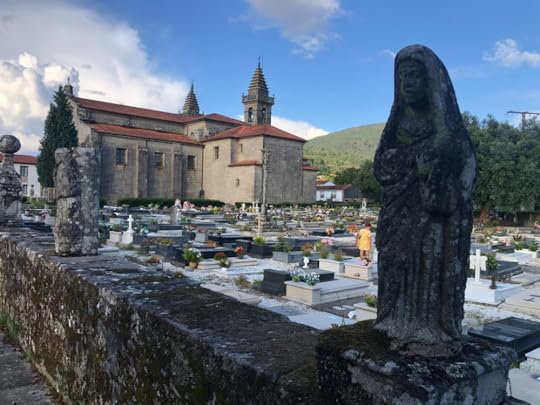
Iria Flavia is just a short distance north of Padrón on the Camino, and it is the site of ,Santa Maria la Mayor, one of the oldest temples dedicated to Mary in the world.
You can walk through Padrón in no time and be on your way, but for me it’s worth hanging around, seeing the sites, and soaking up the ambiance in one of the most significant towns in Camino history outside of Santiago. There are plenty of cafes, bars and accommodations. If you took the boat, it makes for a short walking day, but what's the rush?
<< Back to Armenteira to Vilanova de Arousa: Spiritual Variant Day 2
Armenteira to Vilanova de Arousa: Spiritual Variant Day 2
<< Back to Pontevedra to Armenteira: Spiritual Variant Day 1
Forward to Vilanova de Arousa to Iria Flavia: Spiritual Variant Day 3 >>
This post is part of a series of guides about the Portuguese Coastal Camino. If you're looking for the full rundown on that route, have a look here: What do you REALLY need to know about the Portuguese Coastal Camino?
We’re veering from the main route onto the Spiritual Variant, which is what we did. If you want a guide to the main route, I like ,Pilgrimage Traveler , if you’re looking for a comprehensive turn by turn, or ,Stingy Nomads if you’re looking for more barebones logistics.
Rejoin me at Padrón if you decide against the Spiritual Variant.
 Armenteira to Vilanova de Arousa on the Spiritual VariantDistance
Armenteira to Vilanova de Arousa on the Spiritual VariantDistance23.7 km/14.7 miles
TerrainNot as much of a challenge as yesterday. You start out on a couple miles of downhill forested trail on "La Ruta de la Piedra y del Agua." If it's been raining it can be slick in places but otherwise it's a pleasant walk.
When you start this section, you'll have the option to go on either the right or left hand side of the stream. Either works, but stay right for the most scenic experience.
After that, the terrain levels out and mostly follows the river before descending gradually to the sea at Cores. Some rolling terrain but it's mostly level after the initial descent from Armenteira, walking on paths and pavement.
Important note for tomorrow: If, like most people, you plan to take the boat for the next stage, you need to arrange today if you haven't already. Most people go on the large Barca del Peregrino. There are a few small operators that do the trip as well. In the off season it's a good idea to call ahead to be sure that the boat will be running when you want to take it, because it is dependent on demand.
 Experience
ExperienceIf you've ever gone hiking in the Pacific Northwest, you'll have a bit of a sense of the first part of today's walk. The Ruta de la Piedra y del Agua down from Armenteira passes through ferns and mossy forest, along a series of abandoned stone mills. It's a unique section that doesn't feel like anywhere else on the Coastal Camino, and a lot of people list it as their favorite stage of this walk.
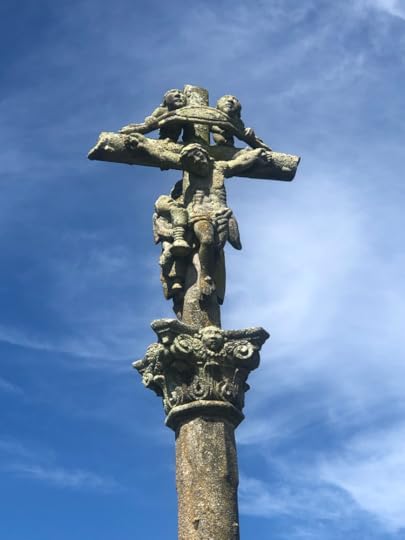
After a couple of miles of this, most of the day is spent following a river, through parks, past cornfields and through small towns. You'll pass a few cafes and bars along the way, and the day makes for a pleasant, relaxed walk. Not as much history and atmosphere as the previous stage, but plenty of natural beauty to make up for it, and a fair amount of shade to keep you cool.

When you get to the coast, you'll track past beaches, campgrounds and parks until you get to Vilanova de Arousa, where you'll cross a pretty bridge into town. If, like most people, you're taking the pilgrim boat (La Barca del Peregrino) the next day, the departure point is clearly visible to the left, and the office where you can buy tickets is to the right. (You can also buy online at their website if you'd like.) We got help from our hospitalero, but honestly it's just as easy to turn up at the office when they're open.
Vilanova de Arousa is a great little coastal town that draws tourists as well as pilgrims. It was a bit sleepy on the Sunday when we arrived until we happened upon a big mariachi concert near an old church. There must’ve been 500 people there, dancing and singing. Good times, and exactly the kind of thing that makes the Camino feel magical.
It's also possible to view some real history here. In the northern part of town, on a hill, are the remains of an 8th century monastery’s at the ,Calogo Tower. A document dated to the late 800's was discovered recently that described a donation to this monastery, and made reference to the pilgrimage to Santiago. It's the region’s oldest reference to the Camino, and proof that this area has been important in the Santiago story from the beginning. It doesn’t get more OG than that!
From here, to me, you really start to feel the massive influence and historical importance of Santiago and the Camino. You aren't far from Santiago now, and it’s a magical last couple of days.
<< Back to Pontevedra to Armenteira: Spiritual Variant Day 1
Forward to Vilanova de Arousa to Iria Flavia: Spiritual Variant Day 3 >>
Pontevedra to Armenteira: Spiritual Variant Day 1
<< Back to Cestantes to Pontevedra: Portuguese Coastal Camino Day 10
Forward to Armenteira to Vilanova de Arousa: Spiritual Variant Day 2 >>
This post is part of a series of guides about the Portuguese Coastal Camino. If you're looking for the full rundown on that route, have a look here: What do you REALLY need to know about the Portuguese Coastal Camino?
We’re veering from the main route onto the Spiritual Variant, which is what we did. If you want a guide to the main route, I like ,Pilgrimage Traveler , if you’re looking for a comprehensive turn by turn, or ,Stingy Nomads if you’re looking for more barebones logistics.
Rejoin me at Padrón if you decide against the Spiritual Variant.
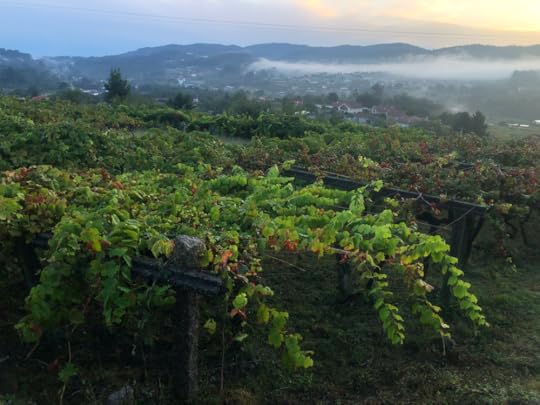 What you need to know about the Spiritual Variant
What you need to know about the Spiritual VariantBefore we get started, here are a few important details about the Spiritual Variant - a side route on the Portuguese Camino that turns off at a well-signposted turn about 3 km after Pontevedra.
It typically takes three days to complete - or to put it another way, it is usually a four day trip from the start of the Spiritual Variant to Santiago. The first three days are on the Variant. The last day is back on the main Portuguese Camino, which you rejoin at Padrón.
This might be a little misleading because for most people the Variant is really a 2 day walk plus a 2 hour boat ride to Padrón. If you get off the boat in the morning, you can fit in a days walk on the same day as the boat ride, making it possible to get from the start of the Variant to Santiago in three days.
The total distances are 46km/28.5 miles of walking and 27.4 km/17 miles on the boat. When you get off the boat, it's 24 km/15 miles to Santiago.
To confuse you even more, you can walk the boat section if you prefer - it mostly follows a road that parallels the route that the boat follows.
If you want to take the boat, you need to arrange it at least the day before, because it often leaves early in the morning and the departure time fluctuates with the tide, so it's a moving target. Most people go on the large Barca del Peregrino. There are a few small operators that do the trip as well. In the off season it's a good idea to call ahead to be sure that the boat will be running when you want to take it, because it is dependent on demand.
The story goes that this route is the origin of all Caminos, because it follows the water route that St. James' bones were said to have traveled when they were brought by his Apostles to Santiago. It’s an old story, but a new walking route that’s been developed and promoted intentionally, rather than a major traditional pilgrim route like the Coastal or Central Caminos. Don’t let that bother you though - it really is a nice option, and it is cool to think that you’re right there where the legends were said to have happened. This whole section makes for a very nice last few days into Santiago, and it would stand on its own as a great little Camino.
It’s much less trafficked than the main routes. It still has plenty of infrastructure, but dividing it up can be a little bit tricky - mainly because the most obvious stopping point - Armentiera - has limited accommodation and doesn’t really cover needs during the high season. Many people use taxis from Armenteira to accommodation options slightly off route.
We walked to Armenteira and taxi’d back to Combarro for the night (about a 15 minute drive), then taxi’d back up the next morning. It’s not a big deal, but it is a cost, and a little bit more of a logistical hassle than other places along the way.
If you’re fit, another option is to stay at Combarro and then have a big day up the hill and over. There are some hotel options along the way, or you could walk all the way to the pilgrim hostels in Vilanova de Arousa, which is about 33 km. This would include the biggest climb of the route (not that it’s really that big) so only try it if you’re fit. No sense risking injuries this close to Santiago. It all depends on how you want to set up your schedule, and how much you want to pay for accommodation.
The Spiritual Variant is well-marked, but we did used our Wise Pilgrim App for navigation a few times if I remember correctly. Food and water were no issues as there are a lot of cafes and bars along the way.
 Distance: Pontevedra to Armenteira
Distance: Pontevedra to Armenteira20.5 km/12.75 Miles
TerrainThe walk between Pontevedra and Combarro is pleasant, on rural roads primarily, with a little bit of climbing. The section between Combarro and Armenteira is renowned for being the hardest climb of the Coastal Camino. Personally, I didn't think it was bad, and felt like the hills out of Vigo were more of a grunt than this. It's about 400 meters/1300 feet of climbing. Not nothing, but it's a long gradual climb across 9 km/5.5 miles. If you've made it this far, you're going to be okay. Try to hit it in the morning if you can, because there is a lot of sun exposure along the way.
 Experience
ExperienceThe route turns off at a well-signposted left about 3 km after leaving Pontevedra.
It passes through some small towns and a cafe here and there.
The first notable stop is the San Xoán de Poio Monastery (at Poio, if that wasn't obvious), about 8 km into the day. It's a really impressive structure with roots tracing back to the 7th century, and it houses a cool, striking Camino de Santiago mosaic. You can stay here as an option and it’s supposed to be fantastic. You're not going to get albergue prices, and you'll need to plan ahead with booking, but seems like it would be worth it.
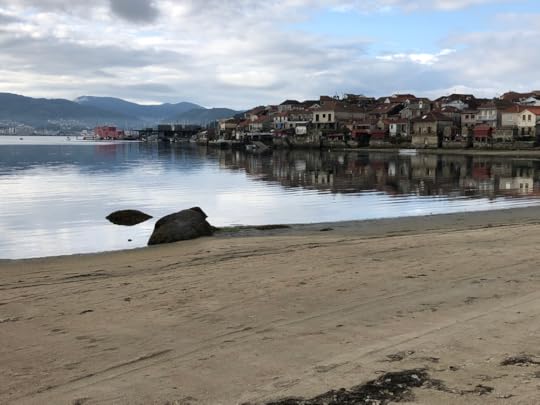
A few km's later, you come to the seaside town of Combarro. Controversial opinion, but Combarro was my favorite part of the Spiritual Variant. It's just a beautiful little place. We stayed here and were so glad. We took a mussel and wine cruise from the port (and accidentally crashed a Portuguese seniors group tour in the process). We saw dolphins jumping. We had dinner as the sun set before wandering the old town in the dark. It was really just a perfect Camino night. The old town is done up for tourists and was a bit busy on the weekend, but it really is picturesque.
There are a lot of good restaurants serving local seafood on the estuary, and you can’t miss the old Crucieros and Horreos here - those stone crosses and raised granaries that you’ve likely been wondering about along the way. The Camino only skirts the edges of Combarro, but even if you aren't staying, it really is worth it to wander a km or two off track to see the town.
From Combarro to Armenteira is a bit of a trudge. People talk about it as the most difficult climb of the Portuguese Camino from Porto, but it's nothing particularly daunting. On the French Camino it would barely rate. It's true, it's uphill most of the 10 km or so, but it's gradual though, not steep. It could be that it seems longer because it's also not a highlight in terms of scenery. There is some pretty rural walking but also some nondescript logging roads. Maybe you'll be questioning the Spiritual Variant along this section, but it’s really just half a day. It’s not bad. Just meh.
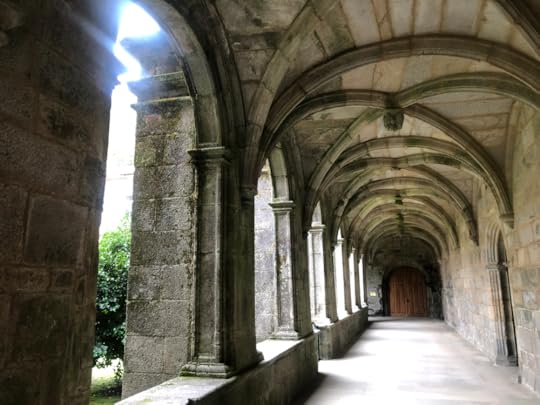
Armenteira though really is cool. This isn’t a town. It’s just a monastery and a couple of bars. There is an albergue, but it’s not huge and it sells out quickly, so ,book ahead, or be prepared with a back up plan during the high season. There’s a ,Hospedaria as well but it only operates for part of the year (and not during high season), and it can’t be reserved ahead. It’ll give you the full monastery experience if you want it.
The ,Monastery itself is gorgeous. Founded in 12th century, it's still home to an active community of ,Cistercian monks. One of them will stamp your passport in the gift shop if you’re lucky enough to find it open. Lots of people come here for a visit so it has a bit of a touristed feel during the day. At night I’m sure it’s lovely but we didn’t stay. As far as town services, there are two cafe/restaurants and a nearby taxi stand - if you need a ride to external accomodation, you can call from there or the bar will help if you if you don't speak Spanish.
<< Back to Cestantes to Pontevedra: Portuguese Coastal Camino Day 10
Forward to Armenteira to Vilanova de Arousa: Spiritual Variant Day 2 >>
October 15, 2023
Cesantes to Pontevedra: Portuguese Coastal Camino Day 10
<< Back to Vigo to Cesantes: Portuguese Coastal Camino Day 9
In this introduction to the stages of the Portuguese Coastal Camino, I'm focusing on the stuff you actually need to know. You'll sort out accommodation and restaurants and so forth on your own as you travel. I'll cover the things that you don't want to miss along the way. For everything else, check out this article: What do you REALLY need to know about the Portuguese Coastal Camino?
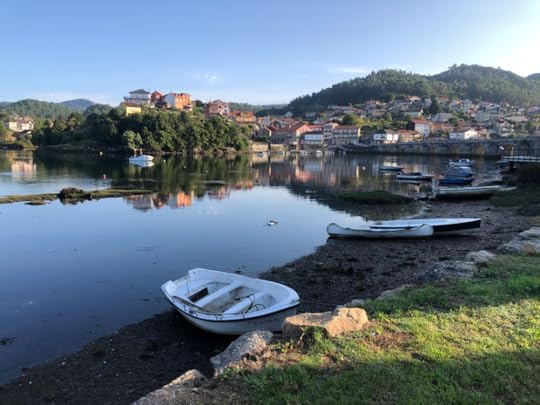 A rundown of the Portuguese Coastal Camino: Cesantes to PontevedraDistance
A rundown of the Portuguese Coastal Camino: Cesantes to PontevedraDistance16.8 km/10.5 Miles
TerrainOut of Cesantes, you need to cross a busy highway - the N550 - and head uphill for a bit. From there you head downhill to Arcade and Pontesampaio and wind through the series of ups and downs through town.
Today is a mix of road, cobblestone streets, and a bit of dirt path.
A few kilometers before Pontevedra, there's a well-marked alternate that follows a path along the river. It's nice - from all reports a better option than the more industrial traditional route.
ExperienceIn contrast to the previous day, this was right up with my favorite days on the Coastal Camino.
Leaving Cesantes, you arrive at Arcade in just 4 km. Stop here for a coffee if you like. The Church of Santiago was constructed in the 12th century, and some of the original is still there, although it’s been updated through the years. Arcade is also known for it’s oysters if that’s your thing. It's not a huge place, but it is a nice place.

Shortly after Arcade, you come to the old stone bridge at Pontesampaio over the Verdugo River. We arrived in the morning light, and it was maybe my personal favorite single scene of the whole Camino. One of the most important battles in Spanish history was fought and won here - a decisive battle in the Napoleonic Wars that helped establish Spanish independence. I’m a sucker for a stone bridge, but this is a nice one by any measure.
After the bridge, you spend some time winding through the old European streets. It's just a fantastic way to spend a morning, and it transports you to a different world.
After you pass out of Arcade/Pontesampaio area you'll pass through a series of small towns and rural scenery for two to three hours before coming to Pontevedra, one of the nicest urban areas on this Camino. (Don't miss the obvious and well-marked river alternate for the most pleasant way to make your way into town.) It's a medium-sized city, much smaller than Vigo, but to me felt bigger than it is. It's lively and more of a tourist center than Vigo, with lovely old squares surrounded by pleasant cafes and bars.
The historic center is compact and really beautiful, with a lot of stunning architecture and multiple beautiful, lively plazas. Check out the 16th Century Basilica of Santa María la Mayor - 16th century and the 13th century Ruins of San Domingos Convent. Wander the narrow streets. Have a beer or an albarino. It's a great place for a day off if you want or need it.
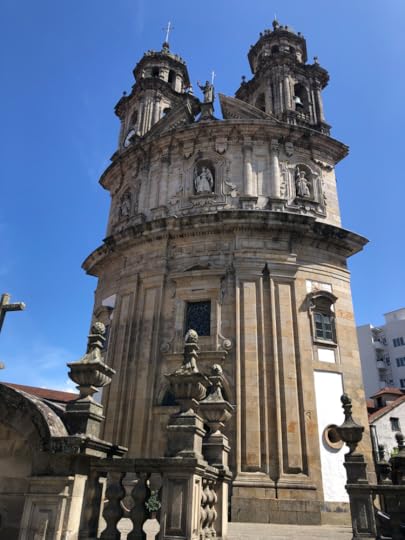
No matter how long you're there, make it a priority to visit the ,Igrexa da Virxe Peregrina. It's right on route and is one of the most famous chapels on this Camino. The chapel itself is shaped like a Scallop shell, and it's decorated with scallop shell motifs and houses a famous icon of the Virgin dressed in traditional pilgrim garb. It was 'only’ built in the 1700s but it’s become an icon of the Portuguese Camino. Less well-known, but a bit more charming, close by is an iconic ,sculpture of the Ravachol Parrot - a cheeky pet of a local pharmacist that became a symbol of Pontevedra. The parrot was named for a famous anarchist because it was, one can assume, a naughty little bird. Reports are that it was famous for it’s profane vocabulary and big personality. These little bits of local identity are a bit of the magic that will stick with you on the Camino.
If you’re following the Spiritual Variant, like we did, the Camino from here is just one good thing after another.
<< Back to Vigo to Cesantes: Portuguese Coastal Camino Day 9
October 14, 2023
Vigo to Cesantes: Portuguese Coastal Camino Day 9
<< Back to Viladesuso to Vigo: Portuguese Coastal Camino Day 8
In this introduction to the stages of the Portuguese Coastal Camino, I'm focusing on the stuff you actually need to know. You'll sort out accommodation and restaurants and so forth on your own as you travel. I'll cover the things that you don't want to miss along the way. For everything else, check out this article: What do you REALLY need to know about the Portuguese Coastal Camino?
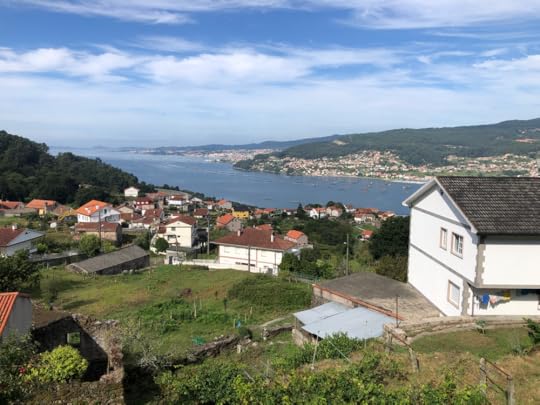 A rundown of the Portuguese Coastal Camino: Vigo to CesantesDistance
A rundown of the Portuguese Coastal Camino: Vigo to CesantesDistance16.4 km/10.2 Miles
TerrainA bit of industrial blah, then a surprisingly tough climb with nice views on city streets out of Vigo, followed by a long stretch of dirt road out of town and some road walking.
Note: This is where the last 100 km starts if you're following the Coastal Route, so it’s an important spot on the modern Camino. You'll need to make sure you get two stamps a day from here if you want your credential, and no more skipping from here! The trail gets a bit more busy and a good number of people start here.
ExperienceThis was probably my least favorite section of our Camino, but that doesn’t mean it is bad. It's just to say that all the others have been very nice. Consistently great. This day has its ups and downs. It’s the least great, but still pretty great.
Leaving Vigo was a surprising trip to. Heading out of town, you face maybe the steepest climb of the trip so far. It might be that I was tired from a long day on the previous stage, but it's a real grind out of Vigo's suburbs. Then there was a long period along dirt trail in green space with no services. Despite being in the biggest city thus far, there wasn't much access to food and water after central Vigo.
Once you get up into the hills in Vigo, it is a really nice walk. The route takes you high so you can get sweeping views, and the greenspace outside of town really is pleasant. Add in the larger volume of pilgrims starting here to get in the last 100 km, and it adds up to quite a different feel from other sections.
Redondela, with its bocadillos and coffee and beers is a welcome sight after 13 km today. After Baiona and Vigo, and before Pontevedra, to me Redondela feels like a relatively nondescript place. Still, there's an energy there because it’s where the Portuguese Central and Coastal Caminos come together. The route abruptly becomes significantly more busy, although nothing like the last 100 km of the Camino Frances.

Redondela also has quite a cool church dedicated to Santiago in the historic center. It's been there since the 11th century but the modern structure was built in the 16th century. It's a nice place to reflect on the history. This place has been serving pilgrims for a thousand years. It really feels like we’re on the Camino, once again.
After Redondela, there are a few kilometers of rolling hills, vinyards, orchards and rural roads. The views back to the water and the striking modern bridge out of VIgo are pleasant.
Cesantes is a nondescript spot really, along a busy highway. There is a nice albergue there but not a lot else. Still, it's a fine place, and stopping there makes for a relaxed day out of Vigo.
<< Back to Viladesuso to Vigo: Portuguese Coastal Camino Day 8



